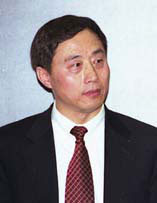Economic Transition and Higher Education Reform in China
When a country changes how it does business, all of its systems-especially education-are modified. China, with one of the fastest growing economies in the world, is a prime example.
The Center on Chinese Education (CoCE) at TC invited Weifang Min, who is the Executive Vice President and Dean of the Graduate School of Education at Peking University, China, to speak about higher education reform in China.
Mun Tsang, Professor of Education and Director of CoCE, introduced Min to the packed room in Grace Dodge Hall. Currently, exchange activities between TC and Peking University include: collaborative research among faculty members, funded by the Ford Foundation; and visiting scholars from Peking University to the Center on Chinese Education, funded by the Henry Luce Foundation.
Before Min started his lecture called, "Economic Transition and Higher Education Reform in China," he stressed that in order to understand how higher education is changing in China, it is necessary to understand its economic transition.
As China shifts from a planned market economy to a dynamic market economy, its higher education system is being reorganized to better prepare its people for the labor market.
The change began with the peasants, who were the weakest link in the planned market economy, because they were less governmentally controlled. Eventually small enterprise grew and established a "special economy zone" that was a window into a dynamic market economy. These zones became examples for other cities in the country.
By the 1990s another component of the transition was completed-the liberalization of prices, he said. Gradually state-owned enterprises became reformed, introduced to the stock system, and the capital market.
From there, private enterprises and joint ventures were developed and promoted. Since it was systematically implemented-on a social, economic and political level-it was a smooth transition, said Min.
As the economic sector took the lead in reform, dramatic changes have taken place in the human resource sector, which is closely tied to the higher education system, he said. Although the new institutions need to gear their programs toward the labor market, all teaching and research should not be shaped by market force. It does mean "human resource needs of the socioeconomic development as signaled by labor market supply and demand will be of primary importance to universities."
With the new fundamental economic structure, higher education had to follow suit. Originally in the centrally planned economy, there were 1054 Universities that produced highly specialized graduates for a specific industry.
"Reorganizing the universities by bridging boundaries of the Ministries, the structure behind the system of higher education changed," said Min. The number of universities is now 600.
They changed teaching and learning methods from memorization of factual knowledge to critical thinking. The number of specialties was reduced from 1400 to 249 to help make the fields of study less specialized.
To finance these changes, they made government spending more favorable to education. It used to be $200 million, but now it's dramatically increased to $500 million.
The government is allowing the university to take advantage of its resources to generate revenue, he said. However, universities will not be transformed into business establishments, they will still be universities.
For more information on CoCE, visit ww.tc.columbia.edu/centers/coce.
Published Monday, May. 20, 2002
